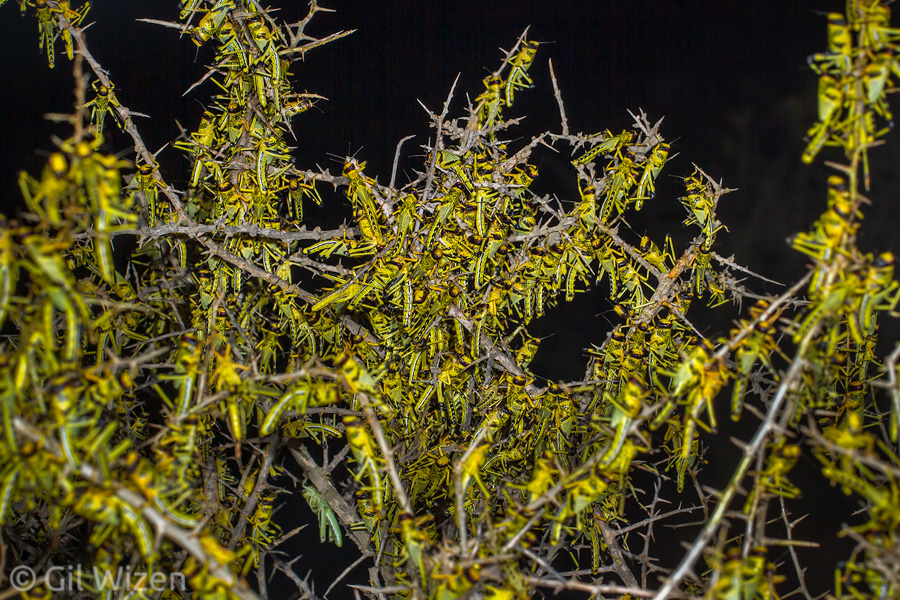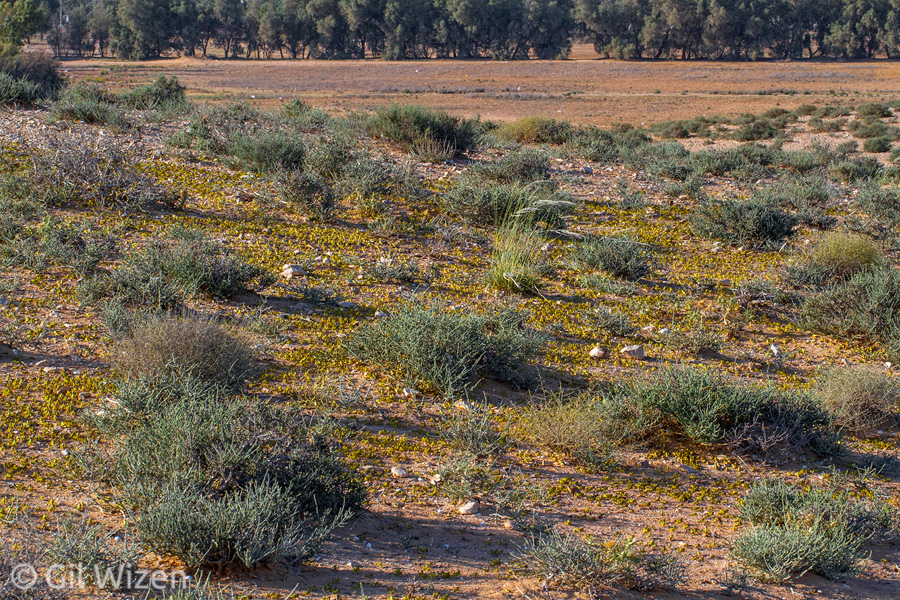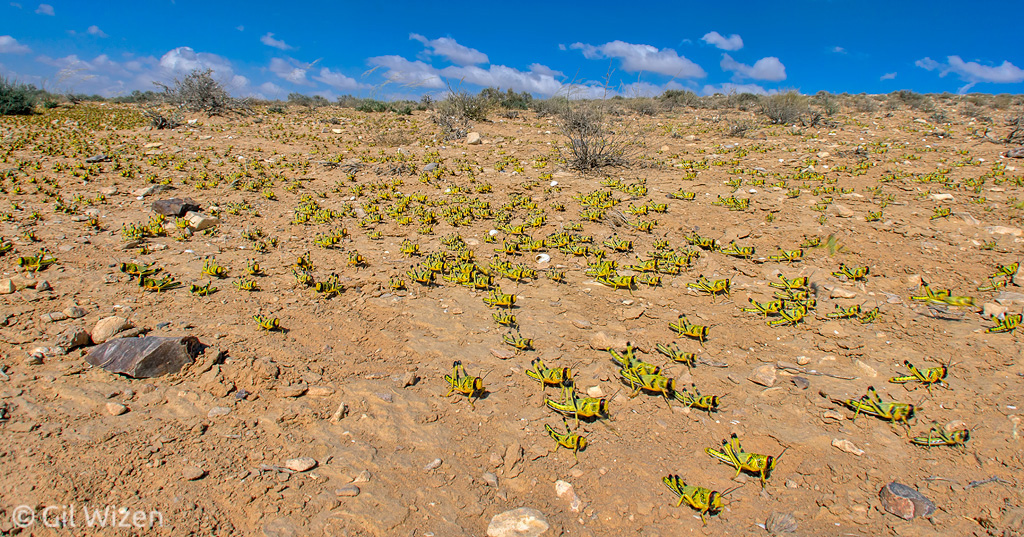A plague of locusts
A couple of years ago, I was driving on a desert road in Israel on my way to several night hiking locations. There was nothing too exciting on the sides of the road vegetation-wise, most plants have finished their short flowering period and dried out. It was a late afternoon, and I got carried away in my thoughts about my approaching night hike. Suddenly I saw a vivid yellow splotch on the ground in the distance. Then another one, and another one. Flowers? Maybe, if it wasn’t for the fact that those spots were moving.
No, not flowers. Insects. Grasshoppers, to be more exact.
It is a common mistake to think that locust grasshoppers are a single species. More accurately, “locust swarm” is the name of a natural phenomenon, in which conditions are favorable for the grasshopper population to increase substantially in size. The phenomenon is known from several species of grasshoppers, all members of family Acrididae. The most famous species is the desert locust (Schistocerca gregaria), found mainly in Africa, but there are other species, mostly found in the Old World and Oceania. Only one species was known from North America, the Rocky Mountain locust (Melanoplus spretus), but it mysteriously disappeared in the late 19th century.

Migratory locust (Locusta migratoria), the most widespeard locust species. Photographed in New Zealand
Grasshoppers usually spend their relatively short lives alone, as solitary animals. In the case of locusts however, when food is abundant and space is tight, they start overcrowding and then an interesting chain of events ensues. The physical contact between individuals triggers a set of physiological and behavioral changes, mediated by the neurotransmitter Serotonin. The grasshoppers start moving and feeding together, they change their appearance from harmless-looking, camouflaged nymphs to bold, frantic ones, sporting aposematic coloration of yellow and black. The group stays together even as they mature into adults, then they turn pinkish in color.
The adult pink grasshoppers soon double, triple, quadruple in their numbers, and food sources become scarce. Then they start taking off, one by one, and glide with the wind until they find a location with food. Very soon they change their color again, this time without the aid of molting, into yellow. At this stage they are sexually active, and the females start laying eggs in the soil.
About three months later, tiny baby grasshoppers hatch. They move together, as a group, crawling and feeding on any green plant they come across. They grow fast, and soon they form small “streams” of yellow, trying to satisfy their enormous appetite.
When I visited the Israeli desert in 2013 I knew about the locusts that arrived from Egypt several months earlier. They had already been “taken care of”, and the only traces of them were dead bodies scattered across the desert. Nevertheless, those grasshoppers had already planted the seeds for a new generation, and sightings of dark “spots” made of grasshoppers started to surface and accumulate. I admit not paying much attention to these reports. To be honest, from what I knew about the Ministry of Agriculture and the Plant Protection Services in Israel, I was certain that the locusts would be exterminated immediately. But apparently they decided to wait. Spraying insecticides from the air is a tough decision, because the harming effects can carry on to non-target insects, some of which are beneficial to us (for example bees), and in turn this could also influence the health and survival of insect-feeding animals such as birds and reptiles.
I only noticed the locusts while I was driving near desert sand dunes, when I suddenly saw what appeared to be the road lifting above the ground. The hoppers were trying to avoid being crushed by the wheels of my vehicle, and man, there were thousands of them.
This was the first time I have seen this phenomenon in its full glory. I was too hesitant to go when the first recent wave of desert locusts arrived in southern Israel in late 2004, and I kicked myself for missing it. I lucked out again as I was out of the country during the next incoming swarm, but was extremely lucky to be around to witness their offsprings.
The interesting thing about the “marching stage” of locusts is that they are very aware of themselves and of their surroundings. I found it extremely difficult to get close to them without triggering an escape response. As a matter of fact, even when I was lying flat on the ground to seem less intimidating to the grasshoppers, they would still approach and stop at 30cm distance. They would then wait for a few minutes, as if to judge what it is in front of them. If one grasshopper either turned back or jumped, the whole band followed. As much as photography goes I believe the only way to photograph them from up close is to use a timer or lie under some kind of camouflaged blanket.
Seeing locusts in the flesh (as opposed to black and white photos of them taken in the 50’s) is impressive. The nymphs move in broad paths that seem endless. Occasionally, a spider or a mantis grabs a nymph as prey, however birds and lizards seem to avoid attacking the hoppers. At night, the locusts can be seen resting in high numbers as they cover bushes and branches, already defoliated from leaves. Some will molt during this time. In the morning they quickly heat up in the sun rays, and go on their way.

Desert locust (Schistocerca gregaria) nymphs crowding at night. Surprisingly, there is one nymph in solitary phase among them (bottom center). Negev Desert, Israel

Desert locust (Schistocerca gregaria) nymphs basking in the sun during the morning hours. Negev Desert, Israel
The sad part about this story is that we usually do not wait long enough to see what happens next. Locust swarms are a destructive force of nature. They can defoliate a crop field within hours. Historically, international alerts were sent whenever a locust swarm was observed airborne. So it came as no surprise to me when I visited the exact same spot the following day, only to find all the locusts dead. Their yellow bodies piled by the thousands under trees and bushes. They were most likely sprayed with insecticides early in the morning, before becoming active. Of all things, this looked like a horrible waste to me. Neither predator nor scavenger came to feed from these now dead grasshoppers, and for a very good reason – they were poisoned. It is none other than a holocaust (of children nonetheless!), but we do not like to think about it this way. We as humans tend to justify our actions when it comes to our own survival as a species. Survival, or world domination? You decide. If only we could accept that grasshoppers are a good food source for ourselves, I believe the response to locust swarms and end result would be slightly different.

Thousands of dead desert locust (Schistocerca gregaria) nymphs after extermination. Negev Desert, Israel

Desert locust (Schistocerca gregaria) adult in solitary phase. This individual was found in the same location two months after I witnessed the extermination of the gregarious nymphs. It is most likely a survivor of that swarm.
Here is a short video of the majestic marching of grasshoppers:








Nash Turley
Wow, great post Gil. Such beautiful animals and so neat to see them all moving together.
Tom Astle
Fascinating post, Gil. I grew in Montana, near the Beartooth Mountains close to Yellowstone Park, where there are a couple of glaciers at high elevation (10,000 feet +) with entombed grasshoppers, which I believe are extinct locusts. I remember my dad telling me that in the short mountain summers, if you were hiking nearby, you could smell them before you could see them. I’m sure nowadays the glacier areas are much smaller — I’ve not yet seen them myself, but I hope I can find them before they all disappear.
wizentrop
Thanks Nash and Tom. The story of the extinct North American locusts is truly remarkable, and there are several possible explanations for their disappearance. I learned that the species was declared extinct by IUCN only recently – in 2014.
Marc
Hello GIl,
I’m Marc Martínez, from the audiovisual production named Stupendastic Films.
We are from Barcelona and we are doing a non-profit video for the FAO, the Food and Agriculture Organization of the United Nations, about the dramatic situation of the Desert Locusts. FAO is now trying to implement drones to detect Desert Locust and prevent their plagues before they destroy the agriculture of the affected countries.
We are now editing this video to promote the idea and we need some good images from desert locusts. We don’t have enough money to travel to Africa and either to buy the expensive clips on Videostock websites, so we need the altruist collaboration from someone.
We really liked the video images we have seen in your website and we thought you maybe would like to share that stock with us. As an exchange, we would insert your name at the end as an acknowledgment and we would share your excellent work: https://www.youtube.com/watch?v=xMR4Jkyomvw
I would like to apologize for my English and for the bold proposal. I suppose you will understand our circumstances and i hope you definitely decide to collaborate with us.
To illustrate the concept of the video, I share you an example of another video we have done using drones to help the world.https://www.youtube.com/watch?v=p_BQdfc5LcU I hope you like it.
Again, congratulations for your excellent work.
Good luck and thank you for your time.
Marc